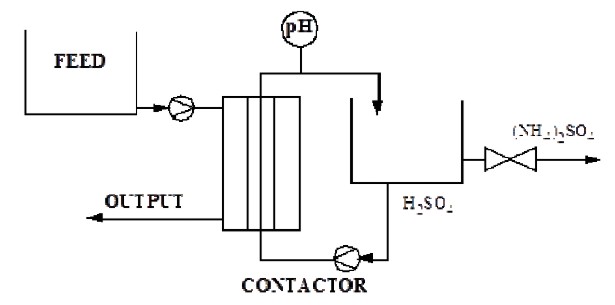The surface of porous polypropylene hollow fibre membranes is strongly hydrophobic (water repellent). Membranes with air filled pores are almost water impermeable but highly permeable to some inorganic gases, e.g. to ammonia. The membrane wall with the dry pores is an ammonia / liquid interface. The liquid phase is waste water. The ammonium mass transfer goes from the liquid phase into absorption liquid. The driving force of the gas transport through the membrane is the chemical potential difference across the membrane.
The pilot test equipment is in the following figure:
The pilot test equipment is in the following figure:

Membrane surface: approximately 20 m2
Housing material: PVC
Module length: 800 mm
Module diameter: 100 mm
Feed water
Temperature: 18 C
N-NH3 concentration: 1000 mg/l
pH: 10.8
pH adjusting: lime milk / caustic soda / sodium alkali /
Heavy liquid (absorption): 10 w/w % sulphuric acid
Non volatile product: ammonium sulphate
Housing material: PVC
Module length: 800 mm
Module diameter: 100 mm
Feed water
Temperature: 18 C
N-NH3 concentration: 1000 mg/l
pH: 10.8
pH adjusting: lime milk / caustic soda / sodium alkali /
Heavy liquid (absorption): 10 w/w % sulphuric acid
Non volatile product: ammonium sulphate

Link na Ammonium Removal from Concentrated Waste Waters.pdf ??
